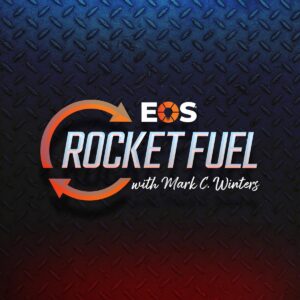When Casey Brown and Gretchen Gordon co-founded Boost Profits, a sales training and coaching company, their shared visionary skills were part of what made them successful.
But once they started operating on EOS®, it became clear that they couldn’t both be in the Visionary role, and Casey wasn’t thriving in the Integrator™ role either. So, what’s the right fit for a founder and president, if not in the Visionary/Integrator™ Duo?
In this episode, Casey breaks down the emotional and strategic process they went through to hire Alex Hayes as the Integrator, nurture a culture of authenticity and vulnerability, and run their business on EOS purity and accountability.
Key Takeaways:
- Having two Visionaries is not a good idea.
- Letting go of control and building new habits requires trust in your counterparts.
- Prioritizing processing your issues creates momentum.
- Clarity and simplicity are what determine the sanity of the Integrator.
Some Questions Asked:
- How do you design an effective process for hiring an Integrator?
- What are the critical strengths that an Integrator should demonstrate?
- Is it possible to be a visionary without being the Visionary?
Building a Culture of Authenticity and Clear Accountability
Casey and Gretchen considered the possibility of having two Visionaries when they started operating Boost Profits on EOS. But when Casey asked Gino Wickman for his advice about their predicament during a Q & A session at the EOS conference, he recommended against it.
So, what’s a homeless Visionary and founder to do? First, Casey moved into an Innovator position, and then she worked with Gretchen to begin their search for an Integrator.
A few important aspects of the hiring process that benefitted both the candidates and their business included:
- Utilizing Vision Spark to help them assess and narrow down candidates.
- Sharing their V/TO™ with candidates to help them understand the clear vision and direction of the business.
- Being vulnerable and transparent in their professional strengths as individuals and as a business, which opened the door for candidates to do the same.
- Using IDS® to solve a real issue that their team had been struggling with to discern how well candidates could problem solve.
Although Casey and Alex had worked together in the past and Casey knew Alex had what it took to lead their team, Alex still went through the carefully designed, rigorous hiring process along with 1,000 other candidates. Alex’s leadership, management skills, and authenticity set her apart and she began the Integrator role.
“We all care really deeply about each other and getting better and we take the time to know what might sting. And you have to really trust and know your counterparts to be able to get to that point. But the only way to do that is to tackle it, and give the feedback and take the feedback and practice.” – Alex [30:14]
Casey and Alex emphasize that naming the unnamed thing in difficult conversations and staying religious about processing issues have helped them stay solution-focused and build trust.
Casey’s insight into the value of only having one Visionary illustrates how it’s still possible to lead your business without being in the official V/I™ Duo.
“The main reason that it was hard to contemplate it was feeling like I was giving up something… what I have found… is that I’ve gained more than I’ve given up… Once you deal with your ego, the rest is easy.” – Casey [37:33]
Alex adds that having one person in each role also dictates the clarity and simplicity of your business, which are key determinants of the Integrator’s sanity.
If you’re interested in implementing EOS and achieving clarity, simplicity, and accountability in your business, don’t miss this episode of Rocket Fuel™.
Learn More:
- Boost Pricing
- Casey’s LinkedIn profile
- Alex’s LinkedIn profile
- Traction by Gino Wickman
- Rocket Fuel by Gino Wickman
- Email | [email protected]
- Email | [email protected]















